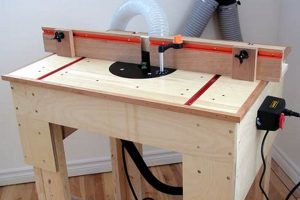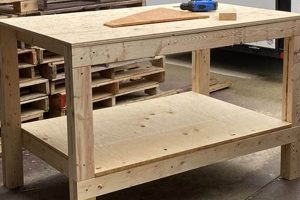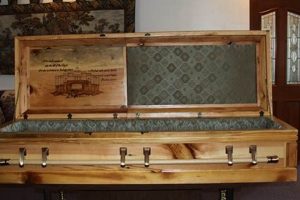The concept allows individuals to design and construct customized cooking and food preparation areas in their exterior living spaces. These constructions range from simple grill surrounds to elaborate structures incorporating sinks, refrigerators, and countertop space. Such projects offer a personalized alternative to pre-fabricated units, often at a lower cost.
Executing this type of project offers significant advantages. Homeowners gain increased control over the layout and materials used, tailoring the space to their specific needs and aesthetic preferences. The ability to adapt the design to the existing landscape and lifestyle enhances property value and provides an improved outdoor experience. Historically, outdoor cooking was a basic necessity; modern versions elevate this practice to a sophisticated form of recreation and entertainment.
Subsequent sections will address critical considerations such as design principles, material selection, essential tools, permitting requirements, and safety protocols to ensure a successful and enduring outcome. These topics provide a framework for approaching the creation of these personalized outdoor spaces.
Essential Guidance for Outdoor Cooking Space Construction
The following points provide key insights for a well-executed outdoor cooking space project, emphasizing durability, functionality, and adherence to regulations.
Tip 1: Comprehensive Planning is Paramount. Prior to commencement, meticulous planning is essential. Detailed blueprints, material lists, and cost estimations should be developed. Site assessment is critical to determine optimal placement, accounting for sunlight exposure, wind direction, and proximity to utilities.
Tip 2: Material Selection Based on Climate. Select materials appropriate for the local climate. Stainless steel, treated lumber, and durable stone are favored choices due to their resistance to weathering and corrosion. Countertops require materials impervious to staining and heat damage.
Tip 3: Adequate Ventilation is Crucial. Design considerations must include proper ventilation, particularly around grilling areas. Insufficient ventilation can lead to smoke accumulation and potential fire hazards. Local building codes dictate specific ventilation requirements.
Tip 4: Utility Access Requires Careful Planning. Integrating utilities, such as gas, water, and electricity, necessitates compliance with local regulations and safety standards. Professional installation is highly recommended to ensure safe and reliable operation. Proper drainage solutions must also be considered.
Tip 5: Securing Necessary Permits. Local municipalities often require permits for outdoor construction projects. Verify permit requirements and obtain necessary approvals before starting construction to avoid potential fines or project delays. Inspections during various phases may be mandated.
Tip 6: Incorporate Ample Storage Solutions. Thoughtful storage solutions are vital for maintaining an organized and efficient cooking area. Weatherproof cabinets and drawers are recommended to protect cookware, utensils, and fuel sources from the elements. Consider integrated trash receptacles for convenience.
Tip 7: Prioritize Durable Countertop Surfaces. The selection of countertop materials significantly impacts the kitchen’s longevity and aesthetic appeal. Materials like granite, concrete, and tile are resistant to scratches, stains, and heat. Proper sealing is essential to prevent moisture damage.
These key insights enable a strategic approach to the creation of a functional and lasting outdoor cooking environment.
Subsequent sections will delve into specific design choices and long-term maintenance considerations for such spaces.
1. Space Optimization
Space optimization within a project refers to the efficient and strategic arrangement of components within a confined area to maximize functionality and usability. In the context of creating outdoor cooking spaces, the available square footage is often a limiting factor, thereby making effective allocation paramount. This involves carefully considering the placement of essential elements such as grills, countertops, sinks, and storage units. Poorly planned layouts can result in cramped conditions, impeding workflow and diminishing the overall utility of the cooking area. For instance, neglecting adequate space around the grill can hinder maneuverability, increasing the risk of accidents and reducing cooking efficiency.
Effective space optimization also involves the implementation of multi-functional design elements. A single countertop may serve both as a food preparation area and a serving surface. Storage solutions can be integrated into the base of cooking islands, maximizing vertical space and minimizing clutter. Furthermore, the incorporation of foldable or retractable features, such as side tables or prep surfaces, enables adaptability for varying usage scenarios. A design that considers the natural flow of movement between preparation, cooking, and serving areas is critical for maximizing efficiency and minimizing congestion.
Ultimately, space optimization is a core determinant of the overall success of any individualized outdoor cooking space. Addressing spatial challenges proactively through meticulous planning and innovative design choices ensures that the resulting structure is not only aesthetically pleasing but also highly functional and conducive to an enjoyable outdoor cooking experience. Failure to prioritize spatial efficiency can compromise the usability and long-term satisfaction with the completed structure. It underscores the need for comprehensive planning before commencing the construction phase.
2. Material Durability
The longevity and functionality of an outdoor cooking space are directly contingent upon the materials selected for its construction. Exposure to environmental elements such as sunlight, rain, temperature fluctuations, and even pests necessitates a focus on material durability. Inferior materials can lead to premature degradation, requiring frequent repairs or complete reconstruction, thereby negating any initial cost savings associated with less robust options. For example, using untreated lumber for framing can result in rot and structural instability within a short timeframe, particularly in regions with high humidity or rainfall. Conversely, employing weather-resistant materials such as stainless steel, treated lumber, or composite decking increases the lifespan of the structure and minimizes long-term maintenance requirements.
The selection of durable materials extends beyond structural components to include countertops, cabinetry, and appliance housings. Countertops constructed from porous materials like untreated concrete are susceptible to staining and cracking, necessitating regular sealing and specialized cleaning. In contrast, granite or engineered stone countertops offer greater resistance to damage and require minimal maintenance. Similarly, cabinets constructed from weather-resistant polymers or stainless steel provide superior protection against moisture and pests compared to traditional wood cabinets. The integration of durable appliance housings further safeguards valuable cooking equipment from the elements, preventing rust and corrosion that can impair performance.
Therefore, material durability is an indispensable consideration when developing plans for outdoor cooking environments. The initial investment in robust, weather-resistant materials translates into reduced maintenance costs, extended structural lifespan, and enhanced user satisfaction. Furthermore, the careful selection of materials contributes to the overall aesthetic appeal of the structure, ensuring that it remains both functional and visually appealing for years to come. Prioritizing durability minimizes the risk of costly repairs or premature replacement, ultimately providing a superior return on investment.
3. Ventilation Adequacy
Ventilation adequacy is a critical design parameter for outdoor cooking spaces, influencing both safety and user comfort. Proper ventilation mitigates the accumulation of smoke, fumes, and heat generated during cooking processes, directly impacting air quality and reducing the risk of potential hazards.
- Smoke Dispersion
Effective ventilation facilitates the dispersion of smoke away from the cooking area, preventing eye and respiratory irritation. Inadequate smoke dispersion can lead to a build-up of particulate matter, posing health risks, especially for individuals with pre-existing respiratory conditions. Design considerations should include prevailing wind patterns and the placement of structures to maximize natural airflow.
- Carbon Monoxide Mitigation
Combustion processes, particularly those involving charcoal or propane grills, produce carbon monoxide (CO), a colorless and odorless gas. Adequate ventilation is essential to dilute and remove CO, preventing dangerous concentrations from accumulating. Enclosed or semi-enclosed spaces require specific attention to ventilation to avoid CO poisoning.
- Heat Dissipation
Cooking equipment generates significant heat, which can lead to discomfort and potentially hazardous conditions. Effective ventilation promotes heat dissipation, maintaining a comfortable temperature within the cooking area. This is particularly important in warm climates or when using high-heat cooking methods. Overhead structures, such as pergolas, can provide shade while allowing for adequate airflow.
- Appliance Performance
Proper ventilation contributes to the optimal performance of cooking appliances. Insufficient airflow can affect the combustion process, reducing the efficiency of grills and smokers. Additionally, excessive heat build-up can damage sensitive components within appliances, shortening their lifespan. Following manufacturer’s recommendations regarding ventilation requirements is essential.
The integration of ventilation solutions into individualized outdoor cooking space plans is not merely an aesthetic consideration but a fundamental safety requirement. Attention to smoke dispersion, carbon monoxide mitigation, heat dissipation, and appliance performance ensures that the cooking area remains a safe and enjoyable environment for all users. Neglecting ventilation needs can compromise the usability and potentially endanger the occupants.
4. Utility Integration
Utility integration represents a crucial, often complex, aspect of outdoor kitchen construction. It involves the seamless incorporation of essential services, such as plumbing for sinks and gas or electrical lines for grills and appliances, into the overall design. The absence of meticulous planning and execution in this area can render the resulting cooking space impractical, unsafe, or even non-compliant with local building codes. A simple example is a grill lacking a readily accessible gas line, necessitating the use of portable propane tanks that can be inconvenient and pose safety risks. Similarly, a sink without proper plumbing connections will require manual water filling and waste disposal, significantly reducing its utility.
The scope of utility integration extends beyond merely connecting appliances. It also encompasses considerations for drainage, particularly in areas with sinks or washdown stations. Inadequate drainage can lead to water accumulation, creating unsanitary conditions and potential structural damage. Furthermore, electrical integration demands careful attention to grounding, weatherproofing of outlets, and compliance with electrical codes to prevent shocks and fire hazards. For instance, outdoor refrigerators require dedicated electrical circuits and ground fault circuit interrupters (GFCIs) to ensure safe operation. Gas line connections necessitate proper sealing and pressure testing to prevent leaks and explosions. These measures require specialized knowledge and adherence to established safety protocols.
Therefore, successful utility integration is not merely a matter of convenience but a fundamental prerequisite for a functional, safe, and compliant outdoor kitchen. It often necessitates the involvement of licensed professionals to ensure adherence to codes and regulations, minimizing the risk of costly errors and potential hazards. Integrating utilities should be viewed as an integral component of the initial planning phase, rather than an afterthought, to ensure a seamless and effective outdoor cooking experience.
5. Code Compliance
Code compliance constitutes a mandatory aspect of any construction project, including individualized outdoor cooking spaces. Failure to adhere to local building codes can result in significant penalties, project delays, or even mandatory demolition of non-compliant structures. These codes are established to ensure public safety, structural integrity, and environmental protection. For example, electrical work must conform to standards outlined in the National Electrical Code (NEC) and local ordinances. Improper wiring or lack of grounding can create fire hazards and pose a risk of electrocution. Similarly, gas line installations are governed by stringent regulations to prevent leaks and explosions. Ignoring these requirements can lead to catastrophic consequences.
The specific codes applicable to outdoor kitchens vary depending on the jurisdiction. Common areas of regulation include setbacks from property lines, maximum structure height, fire safety requirements, and accessibility standards. Additionally, zoning regulations may dictate allowable land uses and restrictions on accessory structures. Real-world examples of code violations include the installation of a gas grill too close to combustible materials, leading to a fire hazard, or the construction of a permanent roof over an outdoor cooking area without proper permitting, resulting in a stop-work order. Furthermore, plumbing connections must adhere to plumbing codes to prevent contamination of the water supply and ensure proper wastewater disposal. These practical examples underscore the importance of understanding and complying with all applicable codes prior to commencing any construction activity.
In summary, code compliance is not an optional consideration but a legal obligation. Understanding and adhering to local building codes is crucial for ensuring the safety, legality, and long-term viability of an individualized outdoor cooking space. Neglecting code compliance can have severe consequences, ranging from financial penalties to safety hazards. It is advisable to consult with local building officials and qualified professionals to ensure that all aspects of the construction project meet the required standards. By prioritizing code compliance, homeowners can avoid costly mistakes and create an outdoor cooking area that is both functional and safe for years to come.
6. Ergonomic Design
Ergonomic design plays a pivotal role in the creation of functional and comfortable outdoor cooking spaces. The principles of ergonomics, when applied to planning, enhance user experience, reduce physical strain, and optimize workflow efficiency. Incorporating these considerations into the blueprint directly impacts the usability and enjoyment of the structure.
- Countertop Height and Depth
Optimal countertop height is crucial for preventing back strain during food preparation. A standard height of 36 inches may be suitable for some, but customization based on the primary user’s height is advisable. Countertop depth should allow comfortable reach without requiring excessive leaning. Adequate workspace depth also supports safe handling of hot items. For example, a taller individual may require a raised countertop surface to maintain proper posture and reduce the risk of injury when engaged in lengthy tasks such as chopping vegetables or kneading dough. Inadequate counter height is a common complaint in poorly designed outdoor kitchens, leading to discomfort and reduced productivity.
- Appliance Placement and Accessibility
The arrangement of appliances, such as grills, smokers, and refrigerators, significantly affects workflow efficiency. Appliances should be strategically placed to minimize unnecessary movement and optimize the cooking process. Frequently used appliances should be easily accessible and positioned within a comfortable reach zone. For instance, placing the grill directly adjacent to a preparation area allows for seamless transition from preparation to cooking. Proper spacing around appliances is also essential to prevent overcrowding and ensure safe operation. Poorly planned appliance placement can lead to hazardous situations and unnecessary delays during the cooking process.
- Storage Solutions and Organization
Thoughtful storage solutions are essential for maintaining an organized and efficient cooking space. Storage should be designed to accommodate frequently used items within easy reach, reducing the need for bending or stretching. Pull-out drawers, adjustable shelving, and vertical storage options can maximize space utilization and enhance accessibility. For example, storing utensils near the grill and spices near the prep area streamlines the cooking process. Adequate storage for cookware, serving dishes, and cleaning supplies is also critical for maintaining a tidy and functional workspace. Disorganized storage can lead to frustration, wasted time, and increased risk of accidents.
- Lighting and Visibility
Adequate lighting is crucial for safety and visibility, particularly during evening hours. Task lighting should be strategically placed to illuminate work surfaces, such as countertops and cooking areas. Ambient lighting can enhance the atmosphere and create a welcoming environment. Consider integrating both direct and indirect lighting options to provide flexibility for different cooking tasks and social gatherings. For example, under-cabinet lighting can illuminate countertops without creating glare, while pathway lighting can improve safety around the perimeter of the kitchen. Insufficient lighting can increase the risk of accidents and make it difficult to perform cooking tasks safely and efficiently.
These facets underscore the value of ergonomic design in outdoor cooking area plans. Consideration for countertop dimensions, appliance positioning, strategic storage, and sufficient lighting significantly impacts the practicality, comfort, and security of the cooking area, increasing its user-friendliness. Applying ergonomic considerations transforms a functional outdoor cooking space into an enjoyable and efficient area.
Frequently Asked Questions
This section addresses commonly encountered inquiries regarding the planning and execution of do-it-yourself outdoor kitchen projects, providing factual and objective responses to assist prospective builders.
Question 1: Are permits invariably required for constructing an outdoor cooking space?
Permitting requirements vary significantly based on location and the scope of the project. Contacting the local building department is essential to ascertain specific regulations pertaining to setbacks, utility connections, and structural specifications. Failure to obtain necessary permits can result in fines or mandatory reconstruction.
Question 2: What constitutes a suitable foundation for an outdoor kitchen structure?
Foundation requirements depend on soil conditions and the weight of the intended structure. Options range from concrete slabs to compacted gravel bases. Uneven or unstable foundations can lead to structural instability, requiring costly repairs. A professional assessment may be necessary to determine the optimal foundation type.
Question 3: Which materials are most resilient for outdoor countertop surfaces?
Countertop materials should exhibit resistance to staining, scratching, heat, and moisture. Granite, sealed concrete, and stainless steel are commonly employed due to their durability and low maintenance requirements. Porous materials, if used, require periodic sealing to prevent damage.
Question 4: How should gas lines be safely installed and connected in an outdoor setup?
Gas line installations must conform to stringent safety standards to prevent leaks and explosions. It is highly recommended that a licensed gas professional perform all gas line connections and pressure testing. DIY gas line work poses significant safety risks and potential code violations.
Question 5: What measures should be taken to ensure adequate drainage around sinks and wet areas?
Proper drainage is crucial to prevent water accumulation and potential damage to the structure. Incorporating a sloped surface and connecting the sink to a drainage system are essential. Standing water can create unsanitary conditions and attract pests.
Question 6: How can the design accommodate varying weather conditions and seasonal changes?
Incorporating weather-resistant materials, providing shade structures, and designing for proper drainage are crucial for adapting to diverse weather conditions. Storage solutions should protect items from moisture and pests. The structure should be designed to withstand local climate extremes.
Successful implementation necessitates careful planning, adherence to safety guidelines, and compliance with local regulations. A thorough understanding of these factors can minimize risks and maximize the longevity of the cooking space.
The subsequent section delves into strategies for maintaining these outdoor environments and ensuring their long-term functionality.
DIY Outdoor Kitchen Plans
The preceding discussion has explored the multifaceted nature of diy outdoor kitchen plans. From the foundational considerations of space optimization and material durability to the critical aspects of ventilation, utility integration, code compliance, and ergonomic design, successful execution requires diligent planning and meticulous attention to detail. Neglecting any of these factors can compromise the functionality, safety, and longevity of the constructed space.
The information provided offers a framework for informed decision-making. Prospective builders are urged to conduct thorough research, consult with qualified professionals when necessary, and prioritize safety and compliance above all else. A well-executed project enhances property value and provides years of enjoyment, while a poorly planned endeavor can result in frustration and unnecessary expense. The ultimate success hinges on a commitment to responsible planning and execution.



![Easy DIY Wire Fish Trap Plans: [Catch More!] The DIY Hub: Creative Crafts, Repairs & Life Hacks Easy DIY Wire Fish Trap Plans: [Catch More!] | The DIY Hub: Creative Crafts, Repairs & Life Hacks](https://craftingdiycenter.com/wp-content/uploads/2025/07/th-1404-300x200.jpg)



